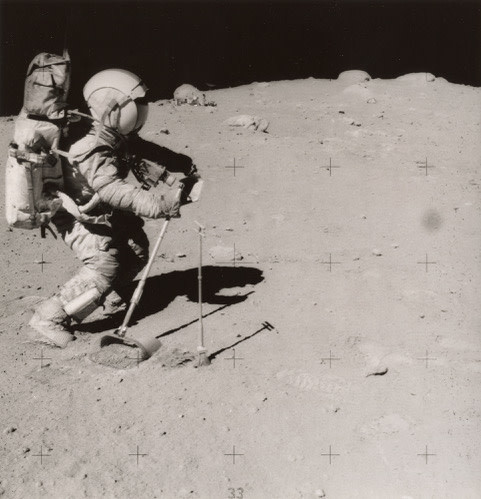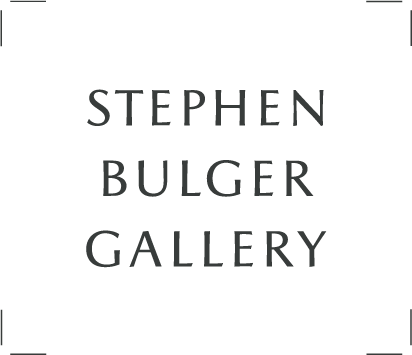Opening Reception: Thursday June 27, 5-8pm
Exhibition Dates: June 28 to August 31, 2019
This exhibition celebrates the 50th anniversary of the moon landing, and our enduring fascination with what lies beyond our atmosphere. Comprised of nearly 200 photographs created over a period of 130 years, the exhibition includes nineteenth-century observations of the Earth’s surface, photographs taken by astronauts on the surface of the Moon, as well as contemporary photographs that reinterpret previously made images of outer space, or offer new perspectives on space exploration.
The installation provides a small chronology of ways that photography has been used in the pursuit of scientific discovery. It includes vintage photographs by James H. Nasmyth; Loewy and Puiseux; NASA astronauts (such as Neil Armstrong, Edwin “Buzz” Aldrin, John Young, and Charles M. Duke, Jr.); unknown photographers; and photographs transmitted from the Ranger and Orbiter Missions. Also included are contemporary photographic works by Benjamin Freedman, Michael Light, Sanaz Mazinani, and Eva Stenram.
Toronto-based photographer Benjamin Freedman’s practice questions photography’s role in describing the world, and its implications within a range of professional practices, particularly in the fields of history and science. While probing the relative truths and deceptions of photography, he purposefully adopts visual vocabularies from genres such as science fiction and horror to create expanded documentary and narrative projects.
During a two-month residency in northern Iceland, Freedman became interested in the country’s unique topographic features. Its low mountains and fascinating geological features inspired Observations of Foreign Objects in a Remote Town (OFORT), a series that illustrates a fictional story about a lunar phenomenon taking place in a sleepy town.
As a medium that boasts power and authority, photography remains a complex tool that inherently elicits the truth while simultaneously hinting at the possibility of fiction. Like images mined from a forgotten archive, images of geological samples of unknown origin and views of deep space act as constellations within an unfolding fictional narrative.
Freedman’s three-panel video projection Apollo Remix engages themes of history, media, and the archive. The internet has become highly saturated with recordings and information about the Apollo 11 space mission, one of the most documented historical events of the past century. Freedman’s experimental film reconstructs the craft’s voyage and subsequent moon landing using video footage sourced from the internet. It addresses the dissociative and fragmentary nature of experiencing historical documentation through an array of online sources. Using existing archival documents as source material, Apollo Remix simultaneously restages and reimagines the mission. Further, it reflects the ongoing critical role of artists as myth makers, in their reconsideration and reconfiguration of history and the dissemination of media.
In 2015, Freedman self-published his first photography book and has exhibited extensively across the Greater Toronto Area, most recently at the Ryerson Image Centre, 8eleven Gallery, and the Art Gallery of Mississauga. He has also shared his work internationally at the Aperture Foundation in New York City.
Michael Light is a San Francisco-based photographer focused on the environment and how contemporary American culture relates to it. Featured in the exhibition are works from Light’s series “Full Moon” (1999) in which he used lunar geological survey imagery made by the Apollo astronauts to show the Moon both as a sublime desert and an embattled point of first human contact.
For the last fifteen years, Light has aerially photographed over settled and unsettled areas of American space, pursuing themes of mapping, vertigo, human impact on the land, and various aspects of geologic time and the sublime. A private pilot and Guggenheim Fellow in photography, he is currently working on an extended aerial survey of the arid Western states. His fourth book with Radius Books, LakeLahontan/Lake Bonneville, will be released in August 2019.
He has exhibited globally, and his work has been collected by the San Francisco Museum of Modern Art, The Getty Research Institute, The Los Angeles County Museum of Art, The New York Public Library, and the Victoria & Albert Museum in London, among many others.
Moritz Loewy (1833–1907) and Pierre-Henri Puiseux (1855–1928), assisted by Charles Le Morvan (1865–1933), undertook a project to make a complete series of detailed photographs of the Moon and the lunar surface. Spanning nearly 14 years, their work of the Moon is considered the finest and most meticulous until modern space exploration begain in the 1960s. Between 1894 and 1909, Loewy and Puiseux devoted approximately 500 evenings to observations in order to make more than 6,000 photographs of the Moon. Their very best images were then published in L'Atlas photographique de la Lune by the Paris Observatory between 1896 and 1910. L’Atlas represents the best and most complete overview of the work of Loewy and Puiseux comprising 12 booklets, 82 heliogravure plates (11 smaller contact plates and 71 enlargements), and texts. The majority of the heliogravure photographic reproductions were entrusted to M. Fillon at Heuse, Gaultier and Schutzenberger, and the enlargements were used to decorate the showroom of the Ministère de l'Instruction Publique during the 1900 Paris Exposition.
Sanaz Mazinani’s work explores how repetition and pattern make information legible. Working across the disciplines of photography, sculpture, and large-scale multimedia installations, Mazinani creates informational objects that invite a rethinking of how we see, suspending the viewer between observation and knowledge.
Solo exhibitions include the Asian Art Museum, San Francisco; Triton Museum of Art, Santa Clara, and West Vancouver Museum. Mazinani has exhibited her work globally at venues in Canada, France, Germany, Guatemala, India, Switzerland, the United Arab Emirates, and the United Kingdom. Her work has also been written about in Artforum, Artnet News, Border Crossings, Canadian Art, San Francisco Chronicle, Washington Post, and has most recently been featured in Universe: Exploring the Astronomical World published by Phaidon (2017).
The Colours of Tethys (300 meters per pixel), is a diptych montage of Saturn’s ice moon, Tethys, and the Carina Nebula. The work shows a range of features on the moon’s trailing hemisphere. The color of the surface can be seen to change across the moon. These broad colour changes are enhanced by the artist to highlight the external processes that effects colour, such as the charged particles from Saturn's radiation belt that bombard the surface, causing hue changes due to chemical alteration of the materials there. Tethys was imaged at a scale of 300 meters per pixel and combined with two projections of the Carina Nebula, showing a region of tremendous star birth and death located 7,500 light years away from Earth.
James H. Nasmyth (1808–1890) was a successful Scottish engineer and inventor who retired at age 48 and turned his attention to astronomy. Nasmyth made sketches of the lunar surface as seen through his 20-inch reflecting telescope. He then used these sketches to construct meticulous plaster models which he lit dramatically in order to take photographs that mimicked the effect of the sun as observed through his 20-inch reflecting telescope. In 1874, he co-wrote The Moon: Considered as a Planet, a World, and a Satellite with James Carpenter, a publication which was illustrated with Woodburytype prints.
Eva Stenram’s photographic practice brings together analogical archival material and digital manipulation, sifting through past and present artifacts, interacting with and re-interpreting the imagery she encounters. Her work is ultimately about being a viewer, a consumer of images.
For “Per Pulverem Ad Astra”, Stenram made negatives from NASA’s digital images of Mars and let these gather dust in her apartment before printing them. The resulting marked image is a combination of extreme distance and extreme proximity, a simultaneous gravitational pull towards the earth, to the dust around – and by extension, towards death – and a pull upwards, into space, away from the earth, towards the attraction, both physical and fantastical, of Mars.





